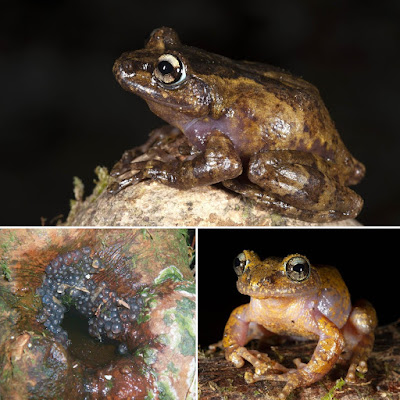Abstract
We describe a new species of phytotelm-breeding rhacophorid frog from central Vietnam. Gracixalus trieng sp. nov. is distinguished from all congeners by a combination of (1) body size medium (37.2–41.4 mm in five adult males), (2) snout rounded in dorsal and lateral views, (3) dorsal surface brown or yellowish with a darker brown interorbital crossbar and inverse-Y shape on the back, (4) throat and chest yellow or yellowish brown with pinkish mottling and belly and ventral surfaces of limbs including hands and feet pinkish, (5) tympanum and supratympanic fold distinct, (6) iris pale gold with darker gold radiating out from anterior and posterior edges of pupil, (7) majority of dorsal body and limb surfaces smooth in adults, with some individuals having sparsely distributed low, irregular tubercles, (8) nuptial pads on fingers I and II in adult males, and (9) eggs deposited as a tightly spaced array of non-pendent eggs on the wall of a phytotelmon. The species occurs in syntopy with G. lumarius. At present, Gracixalus trieng sp. nov. is known only from montane bamboo and evergreen forest (>1700 m) on Mount Ngoc Linh and adjacent peaks; and it is likely to be restricted to high-elevation forest with an estimated geographical distribution of <1000 km2.
Keywords: Amphibia, Anura, Gracixalus, Southeast Asia, Vietnam
 |
| FIGURE 2. Diurnal dorsolateral view (A), nocturnal dorsolateral view (B), dorsal view (C) and ventral view (D) of the holotype of Gracixalus trieng sp. nov. (AMS R176206) in life. |
Gracixalus trieng sp. nov.
Diagnosis: The new species is assigned to the family Rhacophoridae by the presence of intercalary cartilage between the terminal and penultimate phalanges of digits, tips of digits expanded into large discs bearing circummarginal grooves, vomerine teeth absent, pupil horizontal, large, conical tubercles/spines present on the upper eye-lid (Liem 1970; Duellman & Trueb 1986; Brown & Alcala 1994; Delorme et al. 2005), and to the genus Gracixalus by the presence of a dark X, inverted V or inverted Y-shape marking present on the dorsal surface of the trunk (Fei et al. 2009). Gracixalus trieng sp. nov. is distinguished from all congeners by a combination of 1) body size medium (37.2–41.4 mm in five adult males), (2) snout rounded in dorsal and lateral views, (3) dorsal surface brown or yellowish with a darker brown interorbital crossbar and inverse-Y shape on the back, (4) throat and chest yellow or yellowish brown with pinkish mottling and belly and ventral surfaces of limbs including hands and feet pinkish, (5) tympanum and supratympanic fold distinct, (6) iris pale gold with darker gold radiating out from anterior and posterior edges of pupil, (7) majority of dorsal body and limb surfaces smooth in adults, with some individuals having sparsely distributed low, irregular tubercles, (8) nuptial pads on fingers I and II in adult males, and (9) eggs deposited as a tightly spaced array of non-pendent eggs on the wall of a phytotelmon.
 |
| Gracixalus trieng sp. nov., male paratype UNS 00342/AMS R176204, nocturnal coloration. |
 |
| Gracixalus trieng sp. nov., male paratype UNS 00343/AMS R176205, diurnal coloration. |
Etymology: The specific name is in reference to the Giẻ Triêng people, most of whom live in Kon Tum Province in the Central Highlands of Vietnam, and who assisted us greatly during our surveys. The species epithet is used as a noun in apposition.
Suggested Common Name: Trieng Tree Frog (English). Ếch cây giẻ triêng (Vietnamese).
Jodi J. L. Rowley, Duong Thi Thuy Le, Huy Duc Hoang, Trung Tien Cao and Vinh Quang Dau. 2020. A New Species of Phytotelm Breeding Frog (Anura: Rhacophoridae) from the Central Highlands of Vietnam. Zootaxa. 4779(3); 341–354. DOI: 10.11646/zootaxa.4779.3.3
An unusual tree frog discovered in the mountains of Vietnam






